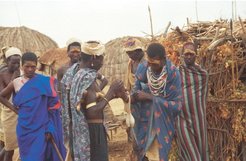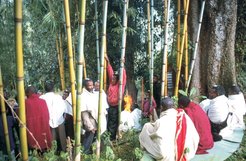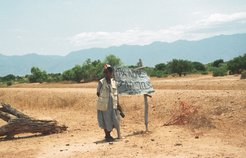Ethnic Groups, the state and the religious landscape in south western Ethiopia
My research in south western Ethiopia covers three interrelated subjects. These are
- inter-group relations and the relationship between groups and the state in the sphere of property
- the study of local non-state (indigenous) structures of power, which control property and much social and cultural life
- the situation of a variety of religions found within the region.

Political structures in the research area are characterized by the prevalence of hierarchically ordered sets of generations. Younger generations supply their seniors with meals, drink and sacrifices (to the dead). Thus they continually look backwards in time in order to move forward. I liken these practices to the act of rowing a boat facing backwards in order to be able to move forward in the opposite direction. Understanding these structures is key to understanding the dynamics of social and cultural reproduction in the region.
Kinship and generations are the routes through which these offerings of food, drink and sacrifices to ancestors are organized. The venues for such kin and age-based events are the house and the wider public spaces. Provisions and offerings are organised both domestically as well as in the public domain. The house, the lineage, the clan and the generation, which combine together to form the groups I work with, reproduce the same principle of feeding seniors and ancestors in their respective domains, in order to reproduce over time. Creative power, blessings and political power are handed down to younger generations in exchange for offerings. Negative attributes such as infertility, misfortune, discontinuity and collapse of order are feared to result if the flow of offerings to seniors and ancestors is interrupted.

Offerings are consumed at selected sites: river banks, valleys, streams, on paths, lake shores, mountain tops, forest groves, peace making sites, fields and mountain pastures. As the venue for communication between generations and as the source of livelihood, land is revered and considered sacred. It is kept potent by a temporally punctuated sacrificial rhythm which complements offerings to seniors and ancestors. Both women and men have sacrificial roles to play (Kashe in Gamo; the wife among the Hor).
In my research area state political structures, and indigenous non-state political structures coexist with a strong bias among the local population towards the latter. Since the early 1990s, people in Ethiopia have been reorganised along ethnic lines. These peoples have been hierarchically ordered in relation to one another as well as to the state. In the new ordering of peoples, ethnic groups are graded into nations, nationalities and peoples. This has benefited larger ethnic groups and has given them the lion's share of political and economic power. Smaller peoples remained marginalised and were lumped territorially into one larger entity to become minorities within the larger ethnic groups. This sort of categorisation and reconstitution of groups has produced an ideology of development designed to reproduce inequality. The originators of the idea, on the other hand, believe that categorising peoples in such a manner creates an ideal situation for fostering political equality and equity. Local people's lives over the last decade however have shown that they are experiencing neither economic equity nor political equality.

My research, carried out in this political and economic context focuses on south western Ethiopian groups such as the Gamo, Konso (pop.) and Hor/Arbore people. Regarding the first theme, my preliminary findings indicate the following: with respect to property, the attitude of the peoples towards the state has changed. There is increased suspicion of the state as upholder of justice and defender of the law. This is a process that has taken over a century to develop and has materialised particularly, when the state appropriated much irrigable fertile land from groups in the south without consultation and without due legal considerations, in order to establish state-owned plantations as well as to distribute the land to outside others. These lands were originally privately owned by members of some of these peoples. In 1975 the revolutionary government (1974-1991) nationalised all land but became the largest landlord in place of the landowners it had abolished by law. Gradually the state appropriated mountain pasturelands and escarpment woodlands for forestry projects while tightening its grip on fertile lowland fields. This resulted in farmers being squeezed off their holdings and pastures, which contributed to low yields of food and growing land insecurity Competition for resources has intensified between the state and agricultural groups and what groups in the south hope for is that the state will heed local knowledge, recognise indigenous tenure and end its involvement in day to day farming activities. They also hope for an end to farmer's time being taken for forced labour and for voluntary conscription thus allowing farming and herding productivity to reach the levels of the mid-1890s, the levels of the mid-1890s, (the pre-conquest period).

Trade networks linking various peoples and markets are widespread and their operation is superimposed on pre-existing networks of friendship. I argue that pre-conquest economic structures are resurfacing and are showing resilience after years of latent inactivity or activity within limited geographical areas. These complement non-state political structures. Trade routes connect the region with the Indian Ocean, the Red Sea, the Lake Turkana region and Southern Sudan. For a few decades after the conquest period these routes were, inactive mainly because of slave raiding and brigandage by the conquest forces.
In the same way as indigenous and state political structures coexist, so do many religious practices coexist in this region.
From my research to date it is therefore clear that inter-group relations of war and peace cannot be understood without taking into account the wider picture of state-local relations as well as the complex inter-relations between various religious traditions and practices.



